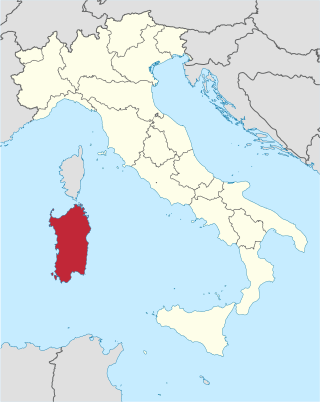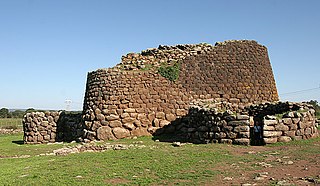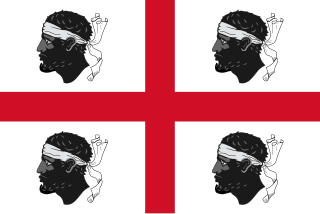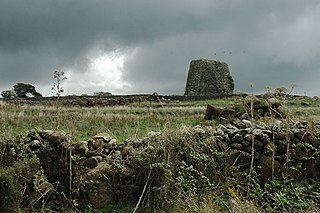Related Research Articles
Eduardo Blasco Ferrer was a Spanish-Italian linguist and a professor at the University of Cagliari, Sardinia. He is best known as the author of several studies about the Paleo-Sardinian and Sardinian language.

Sardinian or Sard is a Romance language spoken by the Sardinians on the Western Mediterranean island of Sardinia.

Sardinia is the second-largest island in the Mediterranean Sea, after Sicily, and one of the twenty regions of Italy. It is located west of the Italian Peninsula, north of Tunisia and 16.45 km south of the French island of Corsica.

The nuraghe, or nurhag, is the main type of ancient megalithic edifice found in Sardinia, Italy, developed during the Nuragic Age between 1900 and 730 BC. Today it has come to be the symbol of Sardinia and its distinctive culture known as the Nuragic civilization. More than 7,000 nuraghes have been found, though archeologists believe that originally there were more than 10,000.

Cagliari is an Italian municipality and the capital and largest city of the island of Sardinia, an autonomous region of Italy. It has about 155,000 inhabitants, while its metropolitan city has about 420,000 inhabitants. According to Eurostat, the population of the functional urban area, the commuting zone of Cagliari, rises to 476,975. Cagliari is the 26th largest city in Italy and the largest city on the island of Sardinia.

The Judicates, in English also referred to as Sardinian Kingdoms, Sardinian Judgedoms or Judicatures, were independent states that took power in Sardinia in the Middle Ages, between the eleventh and fifteenth centuries. They were sovereign states with summa potestas, each with a ruler called judge, with the powers of a king.
Sardinia is probably the most culturally distinct of all the regions in Italy and, musically, is best known for the tenore polyphonic singing, sacred chants called gosos, the launeddas, an ancient instrument that consists of a set of three single-reed pipes, all three mouth-blown simultaneously using circular breathing, with two chanters and one drone and the cantu a chiterra, a monodic song that is accompanied by guitar, widespread mainly in the center and north of the island.

The flag of Sardinia, also referred to as the Four Moors, represents and symbolizes the island of Sardinia (Italy) and its people. It was also the historical flag and coat of arms of the Aragonese, then Spanish, and later Savoyard Kingdom of Sardinia. It was first officially adopted by the autonomous region in 1950 with a revision in 1999, describing it as a "white field with a red cross and a bandaged Moor's head facing away from the hoist in each quarter".

The Golfo di Cagliari, also known as Golfo degli Angeli is a large bay in southern Sardinia, Italy, facing the Tyrrhenian Sea. It is enclosed between the Cape Carbonara from east and the Isola dei Cavoli and Capo Spartivento from west. Its coasts are partly sandy and partly rocky, including only a few harbours. In the middle of the gulf is a Sant'Elia promontory, part of the territory of Cagliari, Sardinia's capital, which also houses the most important port.

The Kingdom of Sardinia, also referred to as the Kingdom ofSardinia-Piedmont, Sardegna and Corsica or Piedmont–Sardinia as a composite state during the Savoyard period, was a country in Southern Europe from the late 13th until the mid-19th century; officially 1297 to 1768 for the Corsican part of this kingdom.

The Nuragic civilization, also known as the Nuragic culture, formed in the Mediterranean island of Sardinia, Italy in the Bronze Age. According to the traditional theory put forward by Giovanni Lilliu in 1966, it developed after multiple migrations from the West of people related to the Beaker culture who conquered and disrupted the local Copper Age cultures; other scholars instead hypothesize an autochthonous origin. It lasted from the 18th century BC, or from the 23rd century BC, up to the Roman colonization in 238 BC. Others date the culture as lasting at least until the 2nd century AD, and in some areas, namely the Barbagia, to the 6th century AD, or possibly even to the 11th century AD. Although it must be remarked that the construction of new nuraghi had already stopped by the 12th-11th century BC, during the Final Bronze Age.

The Sardinians, or Sards, are a Romance language-speaking ethnic group indigenous to Sardinia, from which the western Mediterranean island and autonomous region of Italy derives its name.

The Perfect Fusion was the 1847 act of the Savoyard King Charles Albert of Sardinia which abolished the administrative differences between the mainland states and the island of Sardinia within the Kingdom of Sardinia, in a fashion similar to the Nueva Planta decrees between the Crown of Castile and the realms of the Crown of Aragon between 1707 and 1716 and the Acts of Union between Great Britain and Ireland in 1800.

Paleo-Sardinian, also known as Proto-Sardinian or Nuragic, is an extinct language, or perhaps set of languages, spoken on the Mediterranean island of Sardinia by the ancient Sardinian population during the Nuragic era. Starting from the Roman conquest with the establishment of a specific province, a process of language shift took place, wherein Latin came slowly to be the only language spoken by the islanders. Paleo-Sardinian is thought to have left traces in the island's onomastics as well as toponyms, which appear to preserve grammatical suffixes, and a number of words in the modern Sardinian language.

Sardinian nationalism or also Sardism is a social, cultural and political movement in Sardinia calling for the self-determination of the Sardinian people in a context of national devolution, further autonomy in Italy, or even outright independence from the latter. It also promotes the protection of the island's environment and the preservation of its cultural heritage.

Giovanni Lilliu, was a renowned archeologist, academician, publicist and politician and public figure and an expert of the Nuragic civilization. Largely due to his scientific and archeologic work in the Su Nuraxi di Barumini in Sardinia, Italy, the site was inscribed on the UNESCO list of World Heritage Sites in 1997.

The literature of Sardinia is the literary production of Sardinian authors, as well as the literary production generally referring to Sardinia as an argument, written in various languages.
This article presents a history of Cagliari, an Italian municipality and the capital city of the island of Sardinia. The city has been continuously inhabited since at least the neo-lithic period. Due to its strategic location in the Mediterranean and natural harbor, the city was prized and highly sought after by a number of Mediterranean empires and cultures.

The Byzantine age in Sardinian history conventionally begins with the island's reconquest by Justinian I in 534. This ended the Vandal dominion of the island after about 80 years. There was still a substantial continuity with the Roman phase at this time.
References
- ↑ Mensching, G. Einführing in die Sardische Sprache Romanisticher Verlag (1994) ISBN 3-86143-015-0
- ↑ Polyphonies de Sardaigne, by Bernard Lortat-Jacob, Musée de l'Homme (1981/1992), Le Chant du Monde LDX 274 760
- ↑ Max Leopold Wagner, Dizionario Etimologico Sardo Carl Winter Verlag (1960)